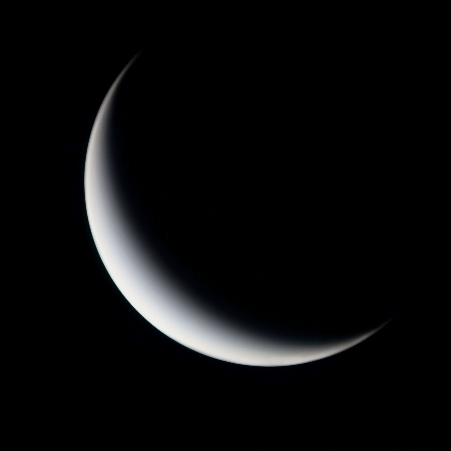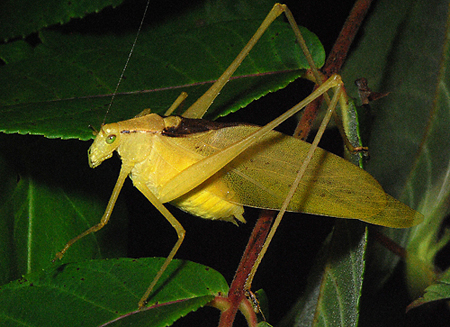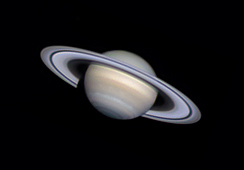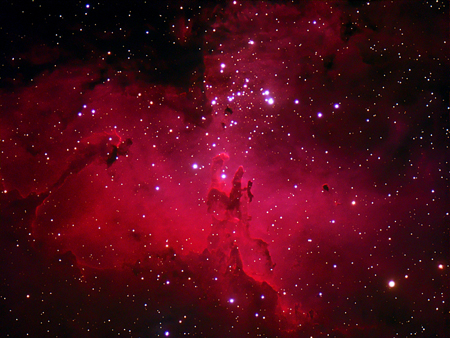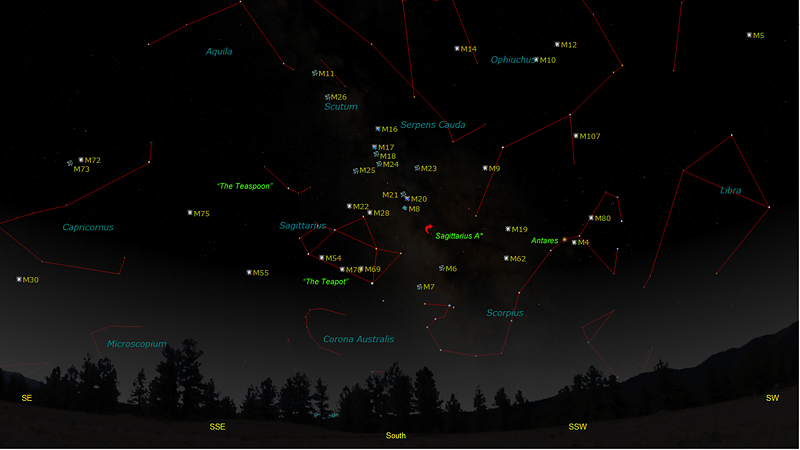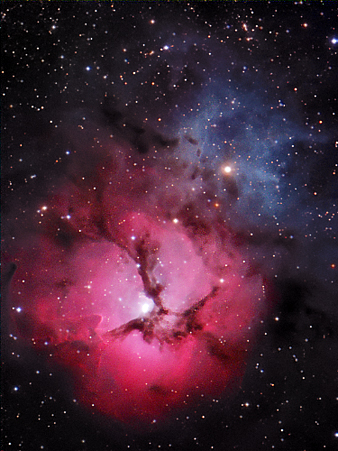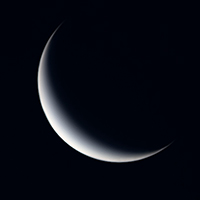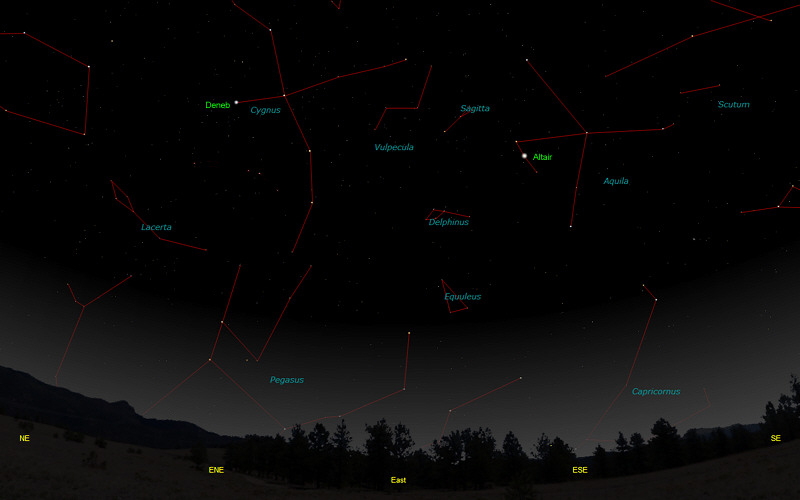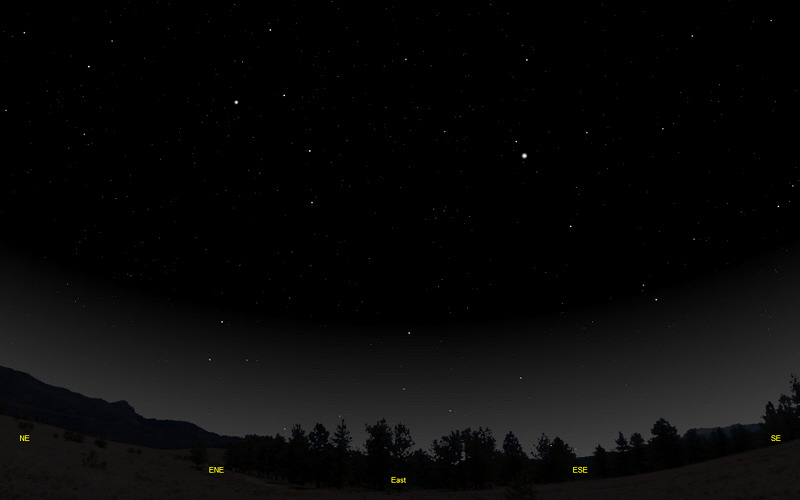(Patience - Slide Show Loading...) The purpose of this feature is to give scout leaders, educators and naturalists an idea of some of the natural events coming up each month. We will try to cover a variety of natural events ranging from sky events to calling periods of amphibians, bird and mammal watching tips, prominent wildflowers and anything else that comes to mind. We will also note prominent constellations appearing over the eastern horizon at mid-evening each month for our area for those who would like to learn the constellations. If you have suggestions for other types of natural information you would like to see added to this calendar, let us know! Note: You can click on the hyperlinks to learn more about some of the featured items. To return to the Calendar, hit the "back" button on your browser, NOT the "back" button on the web page. All charts are available in a "printer friendly" mode, with black stars on a white background. Left clicking on each chart will take you to a printable black and white image. Please note that images on these pages are meant to be displayed at 100%. If your browser zooms into a higher magnification than that, the images may lose quality. Though we link book references to nationwide sources, we encourage you to support your local book store whenever possible. Notes and Images From June 2012
June 5th, the day of the transit of Venus, dawned clear and beautiful . I viewed the transit from Peytonsville, Tennessee, about 15 minutes from our house. This location allowed me to watch the Sun and Venus set over a small ridge about 2 miles away. The temperature crested around 80 degrees, and a cooling northeast breeze kept things very comfortable. A pair of Red-tailed Hawks climbed skyward as I was setting up the scopes. Shortly after Venus appeared, a father and son stopped to have a look. My next door neighbor, on his way to show the transit to a group of boy scouts, also stopped by. I set up two scopes, one for photography and one equipped with the "sun funnel" described last month. The funnel gave a great 5 inch diameter view of the Sun and Venus. I found that with my "eclipse glasses" I could see Venus with the naked eye, a surprise. I realized that I was watching in real time a planet passing from the evening sky to the morning sky. As the sun drew closer to the horizon, a Great Blue Heron flew across it in silhouette. A Northern Mockingbird perched in the top of a Hackberry tree about 70 feet away and sang all afternoon, keeping me company. About an hour before sundown, I swung the telescope over to the mockingbird, took off the solar filter, and took a few shots of my companion. As one of my photographer friends pointed out, the highlight in his eye is a rare one - it mirrors a celestial show that won't happen again in our lifetime!
On June 28th, I got up early and viewed the beautiful, thin crescent of Venus in the dawn sky. The planet is now climbing higher in the east every morning. It was a pleasant undertaking. I set the 20 inch telescope up the night before. My Flea 3 video camera occupied the eyepiece holder of the telescope, but I could still see the brilliant little crescent against the deep blue sky in my 2-inch aperture, 9-power finder scope. Venus approaches the Earth more closely than any other planet and its apparent size varies tremendously. When it transited the Sun, its apparent size was 58 arc seconds. In the image at right, its apparent size is 47 arc seconds. When it is opposite the Sun from the Earth, it can be as small as 9 arc seconds. This morning its image was big and bright on the computer screen. To get a relatively sharp image of Venus, I waited to video the planet until it was about 30 degrees above the horizon. By then the Sun had risen as well. If inadvertently pointed at the Sun, the 20-inch mirror acts like a solar oven, incinerating anything close to its focus, which would include parts of the telescope and my video camera. But the big scope is pretty stable, and I kept it tracking on Venus while recording the 50,000 video frames used to make the above image. The air was still cool at this point, and it felt nice to relax and enjoy the dawn bird chorus. I finished up and by 8:00am the telescope was disassembled and back inside. Good thing, too - later in the day the temperature crested at 105 degrees Fahrenheit, a record for that day in June. The following day the temperature reached 109 degrees Fahrenheit, breaking the all time record high for Nashville. Still, compared to Venus, our surface temperatures are low. Due to a runaway greenhouse effect, the surface temperature on Venus is around 860 degrees Fahrenheit. This is hotter than the surface temperature of Mercury, hot enough to melt lead.
We ranged far from the solar system on June 14th. Using the 20-inch Newtonian reflector, we star-hopped through the constellation Draco to the quasar Q1634+706. The light from this quasar takes 8.6 billion years to reach us. Our solar system formed out of an interstellar gas cloud about 4.6 billion years ago. So in looking at that tiny point of light, we were looking at an object that existed 4 billion years before the Sun and the Earth.
It was an eerie feeling, looking at light that was that ancient. As if to bring us back down to earth, we heard our first Oblong-winged Katydid of the season call from our field as we marveled at the quasar. Unlike the familiar "katydid - katydidn't" call of our Northern True Katydid, this related species does an abrupt raspy call similar to a match being struck. You can listen to one here that we recorded on July 4th, 2011. Northern True Katydids call faintly in the background.
This month we tried out a new inexpensive digital recorder for recording natural sounds. By recording sounds and displaying them on a sonogram (see the Recording Natural Sounds page for details of this and details on the new recorder) you can often identify them and fully appreciate their complexity.
Shown at right is the sonogram of a Eastern Towhee recorded in our front yard. In the lower window, time is on the horizontal axis, frequency is on the vertical axis and intensity (loudness) is proportional to the darkness of the sonogram. You can click the sonogram to play the call. Clicking here will slow the song to 15% of its normal play speed. In the slower speed recording you can hear the complexity of the final trill, which is too fast to appreciate in real time.
Sky Events for July 2012: Earth is at aphelion, its farthest point from the Sun, on July 4th. Evening Sky:
As July begins, Saturn is about 37 degrees above the southwestern horizon at dusk. The bright star Spica, in Virgo, is about 5 degrees below Saturn and almost as bright. The two objects form a striking visual pair. This is a great time to see Saturn, and just about any small telescope will give a great view. Look for Mars about 20 degrees west of Saturn in southern Virgo, about 27 degrees above the southwestern horizon at dusk. Though still relatively bright, Mars is very small (6 seconds of an arc apparent diameter) telescopically. Mercury is visible at dusk in the first week of July before fading rapidly into the solar glare. Begin looking for it about 30 to 40 minutes after sunset wherever you can find a flat western horizon. Binoculars will help you spot it, but wait till the Sun has set to begin sweeping for it. Summer Messier Objects: Looking south on a clear midsummer night yields a treasure trove of Messier clusters and nebulae. The illustration below is made for July 20th at 11:00pm. You will want a clear, moonless evening far from city lights. First, look for Antares, the red giant star that marks the heart of Scorpius, the Scorpion. The name Antares means, "rival of Mars." See if you can trace the tail of the scorpion down almost to the horizon, then back up to the two close stars that mark the stinger. These two stars are sometimes called the "cat's eyes." Due south look for the stars of Sagittarius. The brighter stars form an asterism known as "the teapot." Above the handle of the teapot you can see the four stars that form the asterism known as "the teaspoon." In a dark sky, the clouds of the Milky Way seem to boil out of the spout of the teapot. Above and to the right of the spout of the teapot is the radio source Sagittarius A*. It marks the center of our galaxy. There an enormous black hole with the mass of around 4 million times the mass of the Sun is thought to feed on any stars unlucky enough to wander too close. Nothing unusual is seen visually at this spot, but it's fun to imagine the beast within. This is a beautiful area to scan with binoculars, with many clusters and nebulae. See how far you can trace the Milky Way across the sky (easier if you're far away from city lights). Compare your view of the Milky Way to the image of the edge-on galaxy NGC 4565 we made in April of 2010.
Some of our favorite Messier objects reside in this part of the sky. One of the things that inspired me to build a 6 inch reflecting telescope in high school was an illuminated slide of the Eagle Nebula, M16, that was made by the 200" inch telescope on Palomar Mountain. You won't see the bright colors of these nebulae in a small telescope - the eye is very poor at detecting color at these very low light levels. But it's fun to try to spot the faintly glowing cloud. Another favorite is the Swan Nebula, M17. Here you can see a faint "swan" swimming in a pretty star field. You might also see if you can spot the dark lanes in the Trifid Nebula, M20. A nebula filter will help see detail, but will also tend to alter the appearance of the stars in the field. Above the spout of "the teapot" is Messier 8, the Lagoon Nebula. Don't leave this area without looking at the magnificent globular cluster Messier 22. Look for it slightly above and to the left of the top of the teapot's "lid".
Morning Sky: Jupiter rises about 3:12am on the first of the month. It is soon joined by Venus, which rises about 3:39am. The two planets combine with Aldebaran, the Hyades and the Pleiades to put on quite a show in July's predawn sky. Try looking about an hour before sunrise. The Moon joins the show in mid-July, and Venus, Jupiter, Aldebaran and a crescent Moon form a striking diamond-shaped pattern on the morning of July 15th.
In binoculars or a small telescope, the best views of a crescent Venus come early in the month. Wait until just before sunrise for the best view. After sunrise, I don't recommend viewing because of the possibility of sweeping across the Sun. All times noted in the Sky Events are for Franklin, Tennessee and are Central Daylight Time. These times should be pretty close anywhere in the mid-state area. Constellations: The first pair of charts below shows the sky looking east at 10:00pm CDT on July 15th. The first chart shows the sky with the constellation outlined and names depicted. Star and planet names are in green. Constellation names are in blue. The second view shows the same scene without labels. Prominent constellations this month in the eastern sky are Cygnus, the Swan, with its bright star Deneb, and Aquila, the Eagle, with its bright star Altair. Below and to the left of Altair is the constellation of Delphinus, the Dolphin, looking like it's leaping over the eastern horizon. Above Delphinus look for the arrow-like form of Sagitta, the Arrow. Between Sagitta and Cygnus lie the faint stars of Vulpecula, the Fox.
On Learning the Constellations: We advise learning a few constellations each month, and then following them through the seasons. Once you associate a particular constellation coming over the eastern horizon at a certain time of year, you may start thinking about it like an old friend, looking forward to its arrival each season. The stars in the evening scene above, for instance, will always be in the same place relative to the horizon at the same time and date each July. Of course, the planets do move slowly through the constellations, but with practice you will learn to identify them from their appearance. In particular, learn the brightest stars (like Deneb and Altair in the above scene), for they will guide you to the fainter stars. Once you can locate the more prominent constellations, you can "branch out" to other constellations around them. It may take you a little while to get a sense of scale, to translate what you see on the computer screen or what you see on the page of a book to what you see in the sky. Look for patterns, like the stars that make up the constellation Cygnus. The earth's rotation causes the constellations to appear to move across the sky just as the sun and the moon appear to do. If you go outside earlier than the time shown on the charts, the constellations will be lower to the eastern horizon. If you observe later, they will have climbed higher. As each season progresses, the earth's motion around the sun causes the constellations to appear a little farther towards the west each night for any given time of night. If you want to see where the constellations in the above figures will be on August 15th at 10:00pm CDT, you can stay up till 12:00pm CDT on July 15th and get a preview. The westward motion of the constellations is equivalent to two hours per month. Recommended: Sky & Telescope's Pocket Star Atlas is beautiful, compact star atlas. It is destined to become a classic, and is a joy to use at the telescope. A good book to learn the constellations is Patterns in the Sky, by Hewitt-White. You may also want to check out at H. A. Rey's classic, The Stars, A New Way to See Them. For skywatching tips, an inexpensive good guide is Secrets of Stargazing, by Becky Ramotowski. A good general reference book on astronomy is the Peterson
Field Guide,
A Field Guide to the Stars and Planets, by Pasachoff. The book retails for around $14.00. Starry Night has several software programs for learning the night sky. Visit the Starry Night web site at www.starrynight.com for details.
Amphibians:
With the current drought conditions many small ponds are dry. When conditions are wetter, July’s frogs and toads are much like June’s. Listen for Cope's Gray Treefrogs, Gray Treefrogs, Bird-Voiced Treefrogs, Green Treefrogs and Barking Treefrogs. Northern Cricket Frogs and Southern Cricket Frogs call a lot during July, and the calls of Bullfrogs and Green Frogs fill the night air. After summer thunderstorms listen for the high, insect-like call of the Eastern Narrowmouth Toad and the strange-sounding Eastern Spadefoot. Be sure to look closely at young toads you encounter. Sometimes we find young Eastern Spadefoots foraging during the day. A young Eastern Spadefoot will have vertical pupils, a tiny spade on its rear feet and will often have some red warts, even when only a fraction of an inch long. A hand lens helps to see these features (or turn your binoculars around and use them for a magnifying glass.) Recommended: The Frogs and Toads of North America, Lang Elliott, Houghton Mifflin Co.
Archives (Remember to use the back button on your browser, NOT the back button on the web page!)
Natural Calendar February 2012 Natural Calendar December 2011 Natural Calendar November 2011 Natural Calendar September 2011 Natural Calendar February 2011 Natural Calendar December 2010 Natural Calendar November 2010 Natural Calendar September 2010 Natural Calendar February 2010 Natural Calendar December 2009 Natural Calendar November 2009 Natural Calendar September 2009 Natural Calendar February 2009 Natural Calendar December 2008 Natural Calendar November 2008 Natural Calendar September 2008 Natural Calendar February 2008 Natural Calendar December 2007 Natural Calendar November 2007 Natural Calendar September 2007 Natural Calendar February 2007 Natural Calendar December 2006 Natural Calendar November 2006 Natural Calendar September 2006 Natural Calendar February 2006
Natural Calendar
December 2005
Natural Calendar
November 2005
Natural Calendar
September 2005
Natural Calendar
February 2005
Natural Calendar
December 2004
Natural Calendar
November 2004
Natural Calendar
September 2004
Natural Calendar
February 2004
Natural Calendar
December 2003
Natural Calendar
November 2003
Natural Calendar
September 2003 Natural Calendar February 2003 Natural Calendar December 2002 Natural Calendar November 2002 Nature Notes Archives: Nature Notes was a page we published in 2001 and 2002 containing our observations about everything from the northern lights display of November 2001 to frog and salamander egg masses. Night scenes prepared with The Sky 6 Professional from Software Bisque All images and recordings © 2012 Leaps |
||||||||||||||||||
